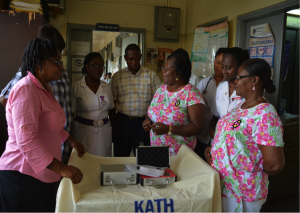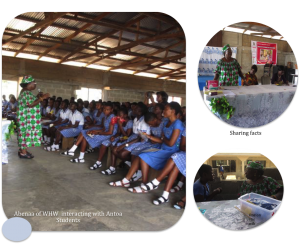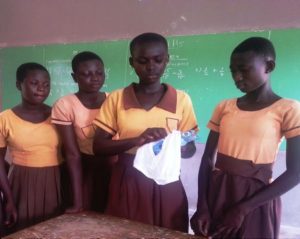Challenges in Getting Girls’ Club Underway
Following our training of our new Girls’ Club facilitators Girls’ Club meetings in all 10 junior high schools began in earnest in the second week of June 2015, once they had been supplied with writing supplies and other materials by Women’s Health to Wealth.
As of end-June, the 10 Clubs had a total membership of 209 girls between 12-16 years old. Club membership ranged from 14, at Worakose Junior High School, to 30, at Piase D/A Junior High.
Each Club has developed a special song and a message for welcoming members to meetings and for ending their sessions.
The Clubs agreed to have three sessions in June, with an expected 100% attendance. However, only 481 girls actually attended, representing roughly three-quarters of the possible 627, due to reported ill health. In the future, with the cooperation of teachers, parents and girls, Women’s Health to Wealth is planning to conduct medical screenings for all Club members and to provide appropriate treatment for those found to have health-related problems. The screenings will take place in September, as soon as schools reopen for the first term of the 2015/2016 academic year.
Meanwhile, each Club has been presented with a First Aid Box that contains medicines for headaches and pains, diarrhoea and dressings for scrapes and cuts, among other things.
WHW has been made aware of seven at-risk girls for whom financial constraints and other domestic problems, such as parental neglect and drunkenness, have made it difficult to attend school regularly. WHW has started the process of speaking with these girls and their parents, to try to find amicable solutions to their various issues and to help keep the girls in school.
Other feedback from both the facilitators and the girls has been heartwarming, as the Clubs are helping to foster bonds of friendship and trust among the girls, and between the girls and their facilitators. Both groups are enjoying the freedom to be themselves during the weekly Club sessions, and in four schools, the Clubs have already been shown to make a positive difference in members’ school attendance, even in these early days.
Nearly 50 per cent of all newborns develop a yellowing of skin and eyes known as jaundice. Newborn jaundice can occur when babies have a high level of a yellow pigment bilirubin produced during the normal breakdown of red blood cells. The high levels of bilirubin are due to the inability of the still- developing liver of the newborn to remove bilirubin.
In most cases the jaundice goes away on its own however the high levels of bilirubin can put a baby at risk for deafness, cerebral palsy or other forms of brain damage and ultimately death. The irreparable damage that can be caused by jaundice in the newborn therefore makes it important that all cases of jaundice are immediately detected and addressed by health providers. The levels of bilirubin can be detected through the skin or blood sample.
In Kumasi, jaundice in the newborn is responsible for the admission of up to one in every five babies at the two low-resource neonatal units and the Komfo Anokye Teaching Hospital (KATH) Mother-Baby-Unit Kumasi.
In KATH, the absence of the means of testing for levels of bilirubin in the unit, babies who show up with jaundice have to be admitted for tests. Mothers of babies admitted with jaundice have to pay between $6 and $8 USD to have the test performed in a laboratory to help doctors determine and confirm the treatment for the jaundiced baby. Laboratory tests typically have a turnaround time of 36 hours with the earliest being 24 hours for mothers who are able to afford it. Delay in early assessment of bilirubin levels due to mothers ability to pay for the test can result in situations where babies who could have been sent home are kept on the already overcrowded unit .
Women’s Health to Wealth (WHW) has been working with KATH to improve neonatal health outcomes. After a careful consideration of the costs of the existing situation in the current diagnosis of jaundice in the MBU decided to acquire some Transcutaneous Bilimeters (TCB)to facilitate the detection and treatment of neonatal jaundice.
With funding support from Women Strong International, a consortium of which WHW is a member, four pieces of TCB were purchased to facilitate the detection and assist in the timely management of neonatal jaundice.

Two pieces of the TCB were donated by WHW to the KATH MBU in June 2015. The equipment was received by the head of the unit, Dr. Gyikua Plange–Rhule in the company of her colleague and administrators. In her acceptance speech, she stressed on the speed of diagnosis and ultimately the efficiency that the equipment would bring to the treatment of sick babies and the unit. She also emphasized the budget relief that the equipment would bring to both mothers and the unit as the TCB can diagnose 500 patients at virtually the cost of 2 AA batteries. Her major concern was with the fragile nature of the black tip cover and the need for users to handle the equipment with care.
On her part, Nana Abenaa Akuamoa-Boateng the executive director of WHW thanked them for the opportunity to make a difference in the care of newborns with the provision of the diagnostic equipment. She however implored them to ensure that the usefulness of the tool is not hampered by the inability to replace the batteries that will cost the department less than $2 a month.
The two low resource MBU at the Kumasi South and Suntreso Hospitals in Kumasi have also been given one TCB each.
WHW wishes to appeal to well meaning individuals interested in donating TCBs to the remaining 35 district facility level hospitals in Ashanti to contact us.
Introduction
Sexual expression is an essential component of healthy human development (Freud, Maslow et al as cited by Zimbardo 1992). However when this expression happens in an unguided manner in young adolescents, the result is the high rates of pregnant teens and teen moms.
The high and unacceptable rates of teenage pregnancy of 99 in 1000 live births in the region coupled with high rates of complications of unsafe abortions among girls in secondary institutions and the low completion rates of girls in second cycle institutions in the region prompted WHW to include the ARHF as one of its strategies to address this menace.
Objectives / purpose of the forum
WHW used this opportunity to
- provide the adolescents with medically accurate sex education and information in school in an age appropriate manner,
- enhance adolescents access to family planning services in confidential manner to promote safer-sex practices in communities.
- identify girls who would be trained as peer educators for their schools to develop communication, negotiation and refusal skills
Participants
Between July and October 31, 2015, WHW organised three separate platforms for sexual reproductive health for girls aged between 15 and 19 years in three Senior High Schools in the Kwabre East district of the Ashanti region. The district is a focus district for WHW programs and also noted to be a district with a high prevalence of teenage pregnancies and high school drop out rates for girls in both Junior and Senior high schools.
Facilitators and Collaborators
The nurses and nutritionists from the Ghana Health Service, the adolescent programme officer from Marie Stopes International and the district officer in-charge of girl child education in the district assisted WHW.
Find below the schedule and numbers of girls who attended each session.
| SNo. | Name of School | Date | No. of participarticipants | No. of Teachers |
| 1 | Simms Senior High School | July 1,2015 | 334 | 6 |
| 2. | Adventists Girls Senior High School | October 2, 2015 | 661 | 10 |
| 3. | Antoa Senior High School | October 30, 2015 | 402 | 8 |
| Total | 1397 | 24 |
Source: Field data, 2015
A total of 1397 students and 24 teachers in three schools attended the three sessions that covered a total of 11 hours. The highest attendance was recorded at the Adventist Girls Senior High School and the least at Simms Senior High School. However the observations and findings were similar in all the schools visited.
The forum provided medically accurate and appropriate information on adolescent reproductive issues such as menstruation, teenage pregnancy, contraception, unsafe abortion, anaemia, nutrition and mental health the global to the local setting.
The girls were given the opportunity to pose questions to the panel. The questions covered a variety of topics from menstruation, sex and sexually transmitted infections (STI), through contraceptives to the issue of sexual abuse by some guardians.
Several students also interacted with members of the panel on a one-on-one basis after the forum to seek guidance on highly personal issues. Girls with STIs in Simms and Adventist Girls Senior High School were referred to the Marie Stopes centre for management. In Antoa Senior High School , WHW organised a medical outreach session a week later to attend to 57 girls who had STI.
Observations and Findings
- All the three schools which are boarding institutions had no infirmary or school nurses on their compound to attend to girls when they have a health problem or handle medical emergencies
- Majority of the girls had been given some amount of adolescent reproductive health knowledge from their female teachers and they had no problems talking about condoms
- Majority of the questions posed to the panel were related to sex and sexually transmitted infections, family planning andcontraception issues, and less than 10 per cent each related to menstrual and nutrition issues
- The panel gave very brief but concrete responses to questions asked by girls
- A large number of the girls had reproductive infections for which they required medical treatment they wanted to discuss with the panel after the programme.
- In two schools, the female teachers expressed a lot of concern about how some of the male teachers were having sexual intercourse with the girls and requested assistance to deal with the problem.
- The medical outreach conducted in one school a week later revealed that, of the 54 girls who turned up with complaints,
- Only 3 had never had sexual intercourse as the vaginal examination and verbal interview confirmed the finding
- 2 had positive pregnancy tests
- 2 already had a child at home
- 3 had symptoms suggestive of pelvic inflammatory disease
- 5 had cervicitis
- 47 had mixed vaginal infections with main organisms being Trichomonas, candidiasis and bacteria vaginosis.
- 28 had already had at least one termination of an unwanted pregnancy.
- Two had normal vaginal pH with no infections
- None of them used a contraceptive during the last sex encounter they had.
All cases of infection were given treatment by the medical team that day. The findings conveyed the urgency of having a school nurse on the compound and also starting a Girls Club to assist address the issues of inadequate knowledge on responsible sex behaviour.
Girls and their “Red Days”
The health of women of all ages is an essential need for sustainable urban development. Research among adolescent girls has shown the importance of education and emotional support in girls’ understanding that the onset of menstruation is a healthy and hopeful part of growing up.
In Akan society, the transition of a girl into womanhood, marked by menarche, is an occasion that is celebrated and held in high esteem by the community. In the days of old, girls who had attained their menarche were ushered into womanhood by a celebration known as “Bragoro.”
Euphemisms such as “w’akum sono” – literally, “she has killed an elephant” – and others, such as “w’ako afikyire” (“she has gone to the backyard”) or “w’abu ne nsa” (“she has broken her hand”), are used to describe the monthly flow of blood, which is linked to fertility and the sanctity of new life.
In the traditional communities of yesteryear, the young girl who had just passed into womanhood would be given an additional piece of cloth to cover her breast down to her knees and would put a loin cloth in between her legs through her circle of gorgeous waist beads, both to catch her monthly flow of blood during her menses and to guard her womanhood from unwanted “visitors.”
In those days, the majority of the girls had their menarche in the latter part of the teens – usually between 16 and 18 years of age. Once the “Bragoro” was performed, the young woman was declared ready for marriage, and no girl worth her salt stayed unmarried more than a year after her “Bragoro.” Those were the days when the lot of a woman was to support her husband and bring forth children, to increase the labour force for their agricultural enterprise.
With improved nutrition, girls today start their menses quite early in life, and it is on record that girls as young as 9 have had their menses, with the average age of onset for the majority of girls being 13. With modernization and the hopeful change in society’s view of female education, early marriages and child brides are not as common as before, and girls are now marrying in their 20s. This positive trend nevertheless poses a major challenge for teenage girls of today, most of whom are in school and have no source of income, yet they need to acquire suitable sanitary pads to deal with their menses.
The days of the loincloth in between the waist beads ended with the invention of disposable sanitary towels. However, these towels come at a cost and not all girls are able to buy them every month. Thus for some school-going girls, absenteeism becomes the norm during the week of their menses. This absenteeism can lead to poor school performance and heighten many girls’ desire to be done with school as soon as possible.
In a bid to encourage girls to go to school and stay in school even during their menses, an organization known as Days for Girls International has introduced the reusable sanitary kit that makes it possible for a girl to purchase a one-time kit that will last over 36 menstrual cycles. By the kind courtesy of Mrs. Patti Law, a Presbyterian Minister from Stratford, Connecticut in the United States, thirty-six kits were donated to the Women’s Health to Wealth to undertake a pilot study with members of the WHW Girls Clubs.
WHW undertook focus group discussions with students of Junior High Schools in in 3 districts Afigya Kwabre, Atwima Kwanwoma, and Kwabre East districts to understand the current knowledge, attitude and practices of teenage girls in the peri-urban communities with regards to the sanitary materials used during their menstrual flow and to explore the acceptability of the reusable kits.
Participants
A total of 99 girls aged between 12 and 18 years participated in 7 focus group discussions. Ninety of the girls had started menstruation while 9 had not attained menarche. See Appendix 1 for more detail.
Objectives
The following outlines the objectives of the focus group discussions:
- To introduce the use of the Days for Girls International reusable sanitary kits.
- To get the views of girls on how they would feel about using the reusable sanitary kit.
- To identify girls who have difficulty purchasing regular sanitary pads as beneficiaries to pilot the free reusable kits.
Overview of Discussions
The discussions that were moderated by WHW team members centered on menstruation, the cost of materials used to staunch flow and how the girls would feel about using a reusable sanitary kit.
The girls were taken through the use of the Days for Girls International sanitary kit which includes a monthly menstrual record chart from WHW, 8 pieces of flannel (reusable pad), 2 shields that holds the flannel in place, a small bar of soap, an empty Ziploc bag and a face towel.
Observations and Findings
- A small number of girls were able to define menstruation and discuss the changes that characterises adolescence.
- A majority of the girls had heard about menstruation before they attained menarche. Over half of them heard about it from their female teachers, while of the remaining half, equal numbers had heard of menstruation from their mothers and from friends. A small minority gave their source of information on menses as female relatives, such as older sisters and grandmothers. Girls confirmed that their mothers hardly interact with them because they disrespect them sometimes.
- Most of the girls said their mothers/guardians warned them after attaining menarche that sexual intercourse with the opposite sex will result in pregnancy.
“My grandmother told me to desist from engaging in unnecessary acts of play with the opposite sex, if not, they will swallow me up!” – a 15-year old club member.
- About half of the participants use sanitary pads in staunching the blood flow during their menses. YAZZ, Proper, Beauty Lady, Soft care, Forever Easy, Yovi, Cute, Always and Sandy are some of the brands used. These pads cost between GHC 3.50-6. The rest of the girls use other toilet paper, baby diapers and pieces of old cloth when they are menstruating.
- About two-thirds of the girls reported that their parents/guardian provide money for their monthly purchase of sanitary pads, while the remainder have to save from their meager daily allowances of GHs1 towards this purchase.
- Girls were very happy when they finally saw the kit of reusable sanitary pads, which they agreed is very attractive.
“This is beautiful! It looks like a handkerchief, and I wouldn’t mind hanging it outside. No one would notice that I use it to manage my menses.” – a 14-year-old girl at Piase.
- Girls indicated their readiness and willingness to buy and use the reusable sanitary pads if the cost of the Days for Girls International sanitary kit is priced between GHC 5-15. Girls claim that the current price quote of GHs 35 will be prohibitive and will incur the wrath of their parents. As aptly said by one 14-year-old girl at Twedie,
“My father will say, quote, “I cannot even afford what I need to buy rat poison to kill myself and be free from the crippling poverty, how can I afford something this expensive!?”
- Apart from a few girls who claim they feel uncomfortable washing their blood-stained panties, the majority of the girls did not seem to have a problem with doing so.
“ I do not have a problem with washing my panties when they are stained with blood because it is from my own private part” – a 15-year-old girl from Esereso.
Based on the interactions with the girls, 25 girls in the four districts were each given a Days for Girls International Sanitary kit.
Next Steps
The 25 beneficiaries in the various districts are to give WHW feedback on the use of the sanitary kits in December 2015. This feedback will be extremely useful in determining whether to promote and get more kits for use by girls in school who have difficulty purchasing regular sanitary pads.
Conclusion
While WHW awaits the feedback from our beneficiaries, we would want to acknowledge with thanks for the gift of 30 kits from Ms. Patti Law, which set us on this path. We also will discuss the cost of the kit with the Days for Girls International office in Accra, as the asking price of GHs 35 is out of reach for the girls we are hoping to serve.
- « Previous
- 1
- …
- 4
- 5
- 6



